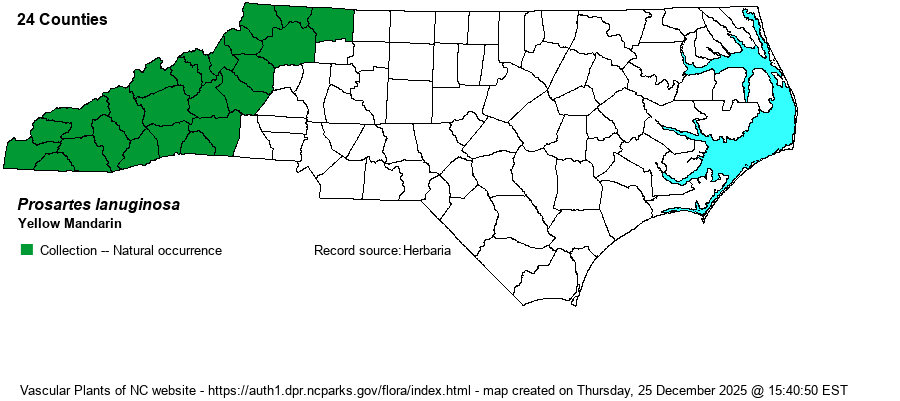| Author | (Michaux) D. Don | |
| Distribution | Throughout the Mountains, and into the highest portions of the adjacent Piedmont, though not found on isolated ranges or monadnocks in the latter province.
This is a broadly Appalachian species, ranging from western NY and southern ON, south mainly in the Mountains to northwestern SC, northern GA, and central AL. It is disjunct to AR. | |
| Abundance | Common and widespread in the Mountains, being a characteristic and often seen member of the herbaceous flora of cove forests. Uncommon in the adjacent Piedmont. Despite it being known from just 24 counties, the NC NHP has given it a State Rank of S5, not often given to species whose sole range in the state is just the Mountains. | |
| Habitat | This is a classic species of Rich Cove Forests, often one of the first herbaceous species one sees when encountering this natural community. It can occur into some Northern Hardwood Forests and some Acidic Cove Forests, but it is always found in rich to very rich montane forested soils. |
| Phenology | Blooms in April and May, and fruits in August and September. | |
| Identification | This lily grows to about 1.5-2 feet tall, usually with a number of branches coming off the stem, to give a somewhat rounded look to the plant when viewed from above. The leaves are arranged alternately, and each is about 3-4 inches long with deeply indented parallel veins. At the end of each of several branches hang 1-3 medium-sized dull yellow or greenish-yellow flowers, with no spots on the tepals. Each flower dangles downward and is about 1 inch across; the tepals are somewhat spreading and are quite narrow. The quite similar Prosartes maculatum has a similar growth form, but it has slightly larger white flowers that are conspicuously dotted with purple. The two Streptopus species can have a somewhat similar growth form, with branched stems, but they have small, bell-shaped flowers. The very common False Solomon's-seal (Maianthemum racemosum) has stems that are unbranched, and the inflorescence is a terminal white cluster. As mentioned above, most observers should be able to encounter P. lanuginosa readily in a walk in a cove forest. However, the flowers are not overly obvious, as they are only slightly lighter in color than the leaves, and they are often hidden beneath the leaves, as well. | |
| Taxonomic Comments | Until fairly recently the two NC species of Prosartes were placed in the genus Disporum; thus, this was Disporum lanuginosum.
| |
| Other Common Name(s) | Yellow Fairybells, Hairy Mandarin | |
| State Rank | S5 | |
| Global Rank | G5 | |
| State Status | | |
| US Status | | |
| USACE-agcp | | |
| USACE-emp | | |

